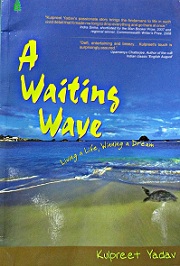|
by Goh Cheng Fai Zach
 
Kulpreet Yadav, A Waiting Wave, Cedar Books, 2011. 176 pgs.
Shivani Sivagurunathan, Wildlife on Coal Island, Universiti Putra Malaysia Press, 2011. 158 pgs.
The Boxing Day tsunami of 2004, which killed more than 230,000 people in fourteen countries, is one of the deadliest natural disasters in recorded history. The influence of this momentous event can still be felt throughout South-East Asia, including in the literature of the region. It is a driving force in Kulpreet Yadav's short novel, A Waiting Wave, which takes place on the Andaman and Nicobar Islands. It also has a smaller but still discernible impact in Shivani Sivagurunathan's Wildlife on Coal Island, a collection of short stories set on the titular and fictional island of modern-day Malaysia. As suggested by the title Wildlife on Coal Island, animals feature heavily in the eleven stories which make up the collection. (Two of these stories, "The Bat Whisperer" and "Catching Iguanas", have appeared in Cha.) Tapirs, mynah birds, chameleons, iguanas, parrots and bats inhabit the island, sharing space with its human residents. This cohabitation is central to many of the stories, such as in the relationship between a pet monkey and an ageing Chinese opera singer, a flock of kingfishers that foretells doom for a self-proclaimed psychic and a python which does battle with a former colonial plantation overseer. Sivagurunathan's stories explore the particularities of island life, but they are also about Malaysia more generally. Local readers will have few problems recognising national stereotypes, such as the nosy "aunty" next door or the country's obsession with national examinations. The dialogue used in some of the stories also has a strongly local flavour, which could be challenging to readers who are not familiar with Malaysian English. Despite these national traits, however, Coal Island, like all islands, has a personality distinct from the mainland. Sivagurunathan uses a different narrator for each of the stories, enabling her to give readers a sense of the individuals that make up the whole. This whole turns out to be slightly off-kilter, and there is a sense of unrealism in the collection, as if life on the island has slightly detached from reality—separation from the mainland allowing the unusual to become the usual. For example, at one point, Coal Island is described as "a place of secrets, gossip and murder," and in the first story "All About the Monkey," Kumar says that his favourite fact about his home is that "unlike other parts of Malaysia, Coal Island doesn't produce red watermelons, only the yellow kind." Similarly, in the last story, "The Bat Whisperer," Pong Pong, a gay Hindu resident of the island, has the ability to talk to bats and uses his talent to communicate with those that live on the rooftops of other people's houses. Apart from these, there are a plenty of other people and animals to be encountered in Shivani Sivagurunathan's unique take on island life in Wildlife on Coal Island. Kulpreet Yadav's novel A Waiting Wave also explores island life, in this case that as it is found throughout the various territories in the Andaman and Nicobar Islands. The novel—which reads like a cross between a romance and adventure tale—is divided into two sections: before and after the tsunami strikes. The book tells the two simultaneous stories of Harry and his wife Kareena, a newly married Indian couple living in Delhi. To reflect this dual narrative, the novel is written from two perspectives: Harry tells his own story in the first person, while Kareena's is told from a third-person perspective. This change in speaker can be confusing at times, particularly since the book often lacks clear transitions or chapter breaks between the two narratives. Soon, the couple faces marital problems, and Harry decides to seek refuge from his wife in his father's house in Port Blair, the capital of the Andaman and Nicobar Islands. Unable to find solace on land, he takes to the sea and is boating when the tsunami suddenly strikes. When he comes to, he finds himself on the Island of the Sentinelese, home to the violent and isolated Negrito tribe. From here, the narrative advances to other islands in the region. At several points, like in Wildlife in Coal Island, the novel also explores themes of the unreal. For example, Harry has a strange encounter with what he believes are the ghosts of Japanese soldiers from the Second World War. Spirits also play a part in the ending of the story. The Nicobarese tribes, another ethnic group found in the area, believe their ancestral spirits will visit them every five years, but only if there is a marriage, and that if the ritual is not observed, the tribe will perish from a mysterious disease. Fortunately, the crisis is averted at the last minute by Harry and Kareena. Despite the dangerous and "primitive" residents the couple face in the novel, Yadav ultimately eulogises the uniqueness of tribal life in the Andaman and Nicobar Islands. In the epilogue of A Waiting Wave, he writes: During the tsunami of 2004 not even a single tribal soul lost his life, whereas thousands others in the Andaman and Nicobar Islands perished. How did the tribal people learn about this impending disaster? What prepared them? As their population is dwindling and their methods of life are getting compromised by poachers and settlers from mainland India, the modern world is perhaps on the verge of losing an understanding of their skills forever. Each in their own way, both A Waiting Wave and Wildlife on Coal Island are celebrations of island life, a call for us to embrace the mysteries, folk knowledge and unique ways of life found on the isolated pockets of land that dot the seas. |